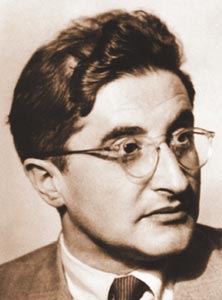George Placzek was a Czech physicist. He was born in Brno, Moravia, which was then part of Austria-Hungary but today is in the Czech Republic. From 1918 to 1924, he studied at the Deutsches Staatsgymnasium in Brno before going on to receive his Ph.D. at the University of Vienna in 1928. For his dissertation, Placzek wrote about the determination of density and shape of submicroscopic test bodies.
Placzek spent the next decade traveling throughout Europe, working with Hendrik Kramers in Utrecht, Weiner Heisenberg in Leipzig, and Enrico Fermi in Rome before settling in Copenhagen to work with Niels Bohr from 1932-1938. Hans Bethe recalled on a visit to Rome during this time:
I developed a nice relationship with Placzek, who was one of the nicest and thorough going people I have known. He was indeed studying the Raman effect of molecules, and later on he studied the behavior of neutrons diffusing through matter. Every time he was extremely thorough and went to the sources. Usually, he loved the library at the Institute in Rome because he could follow the subject of light scattering back to 1800, and he then used that in his article. We went out to dinner together every day, and remained friends ever since.
Placzek’s scientific interests during this period were indeed focused on the diffusion of light through liquids and gas, which is known as the Raman effect. Together with Lev Landau, he developed the Landau-Placzek formula for the ratio of diffusions of light. During his work with Bohr, Plazcek published one of the first papers ever written on the general theory of a neutron based nuclear reaction. In their later work, Plazcek and Bohr would also discover the importance of Uranium-235 in creating a nuclear reaction.
Because of the growing danger of Hitler’s expansion in Europe, Placzek moved together with Bohr to Princeton University in 1939 before accepting a position to teach at Cornell University. With the race for the atomic bomb underway, in 1942 Placzek became the head of the Theory Group at the Chalk River Laboratories in Montreal, a joint British-Canadian uranium research project. In May 1945, he went to Los Alamos to help with the final work on the Manhattan Project, and was the only Czech citizen to work on the project.
After the war, Placzek worked at the General Electric Research Laboratory for two years, before accepting a permanent position at the Institute for Advanced Study at Princeton, NJ. One of his only published works, Introduction to the Theory of Neutron Diffusion, appeared in 1954. As Edoardo Amaldi later recalled, “The redaction of an article represented an immense effort for him; even important results of his, which he had formulated clearly and in definite form, often remained unpublished.”
Plazcek died on October 9, 1955, in Zurich. He was celebrated at a symposium honoring the centennial of his birth in September of 2005, in Brno.





